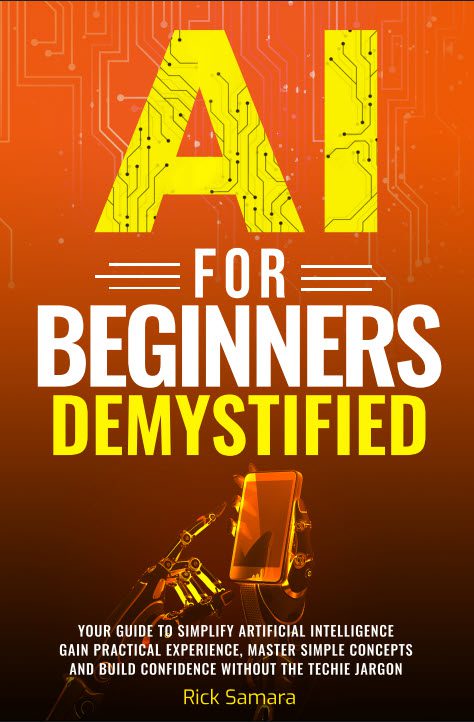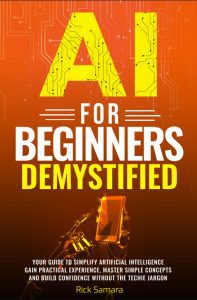 As you know, EIMS has been promoting AI Employee. AI Employee is a suite of six AI tools, plus a CRM, designed to help small business improve their productivity and efficiency. The problem is that 85% of people are intimidated by Artificial Intelligence. As students of AI and in an attempt to break down barriers toward this new and evolving technology, Rick researched and wrote “AI for Beginners Demystified.” This book is now available on Amazon Kindle. In this book, Rick turns confusion and uncertainty into clarity and fear into fun. Imagine sitting down with a friend over a cup of coffee, sharing laughs while unraveling the mysteries of AI. That’s precisely what this book offers. By the end, you won’t just understand AI, you’ll feel empowered to engage with it.
As you know, EIMS has been promoting AI Employee. AI Employee is a suite of six AI tools, plus a CRM, designed to help small business improve their productivity and efficiency. The problem is that 85% of people are intimidated by Artificial Intelligence. As students of AI and in an attempt to break down barriers toward this new and evolving technology, Rick researched and wrote “AI for Beginners Demystified.” This book is now available on Amazon Kindle. In this book, Rick turns confusion and uncertainty into clarity and fear into fun. Imagine sitting down with a friend over a cup of coffee, sharing laughs while unraveling the mysteries of AI. That’s precisely what this book offers. By the end, you won’t just understand AI, you’ll feel empowered to engage with it.
“AI for Beginners Demystified” is positioned as an engaging and accessible entry point into the world of Artificial Intelligence. By leveraging humor, relatable anecdotes, and a commitment to simplifying complex concepts, the book aims to alleviate the common apprehension surrounding AI and empower a broad audience to understand and interact with this rapidly evolving technology. The following provides an overview of the book by capturing the key points of every chapter.
Introduction
The introduction sets the stage for demystifying AI, drawing from the author’s background as a U.S. Air Force Intelligence Analyst, where he simplified complex data. He aims to break down AI into simple concepts using real-life examples and personal stories, making it accessible for beginners of all ages. The goal is to build confidence in understanding AI basics, its everyday applications (like in smartphones), and how to leverage it personally and professionally. He addresses natural skepticism toward new technology, quoting Sal Khan on AI’s dual nature as both a fear and an equalizer. The author shares his journey from military briefings to owning an internet marketing company, using AI to enhance efficiency. He emphasizes curiosity over age and injects humor to make learning enjoyable.
Chapter 1: Roadblocks to AI
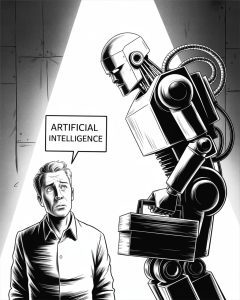 This chapter addresses common skepticism and confusion around AI, comparing it to past innovations like automobiles and computers. It explains why people resist AI due to fear of the unknown, media hype, and misconceptions like world domination or job loss.
This chapter addresses common skepticism and confusion around AI, comparing it to past innovations like automobiles and computers. It explains why people resist AI due to fear of the unknown, media hype, and misconceptions like world domination or job loss.
Why Are People Skeptical About Artificial Intelligence?
Skepticism stems from fear of disruption, job displacement, and sensational stories. The author debunks myths, noting AI creates new roles (e.g., AI trainers) and cites the World Economic Forum’s prediction of 78 million net job gains by 2030. He reassures that AI is a tool to enhance human work.
AI is Daunting and Confusing
AI’s rapid integration into platforms can overwhelm beginners. The chapter promises to avoid jargon, focusing on personal insights and real-life examples to make AI approachable.
Chapter 2: Laying the Groundwork
The chapter provides foundational knowledge on AI, tracing its evolution and clarifying the buzzword. It uses everyday examples to make concepts relatable.
What is AI? Demystifying the Buzzword
AI simulates human intelligence for tasks like language understanding, pattern recognition, and decision-making. Examples include voice assistants (e.g., Google, Alexa) and recommendation systems like Amazon or Netflix.
Evolution of AI
AI began at the 1956 Dartmouth Conference. Early milestones include ELIZA (1960s chatbot) and the Turing Test. The chapter highlights progress from simple programs to complex systems impacting industries.
Chapter 3: Artificial Intelligence (AI): It’s Moving Parts
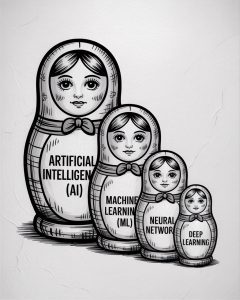 This chapter breaks down AI’s components using nesting dolls, explaining their interconnections without jargon.
This chapter breaks down AI’s components using nesting dolls, explaining their interconnections without jargon.
Machine Learning (ML): The Heart of AI
ML enables systems to learn from data, unlike traditional programming. It includes reinforcement learning (e.g., gaming) and data processing for accuracy.
Neural Networks: A Subset of Machine Learning
Inspired by the brain, neural networks process data through layers of nodes for tasks like image recognition (e.g., facial unlock).
Deep Learning: Differentiating AI, ML, Neural Networks & Deep Learning
Deep learning uses multi-layered neural networks for complex patterns (e.g., speech recognition, Google Translate).
Generative AI – Content Creation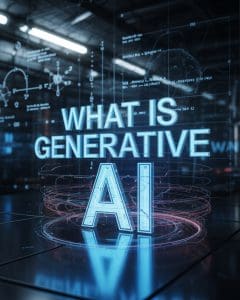
Generative AI creates content like text, images, or music using learned patterns.
Avoiding Jargon: Keeping it Simple
The author stresses simple explanations, analogies, and hands-on engagement to make AI enjoyable.
Chapter 4: Handy AI Tools That Already Impact Our Lives
The chapter explores AI in everyday devices, based on the author’s experiences as an internet marketing owner.
Smartphones
AI powers virtual assistants (Siri, Google), photo editing, personalization (news feeds, music), and security (facial recognition, malware detection). Future uses include health monitoring.
detection). Future uses include health monitoring.
Smart Homes: The AI Behind Your Gadgets
Smart thermostats learn preferences; voice assistants like Alexa enable hands-free control. Examples include iRobot vacuums and personal stories.
Chapter 5: AI – The New Revolution in Technology
AI transforms industries, driving efficiency and innovation.
AI on the Highway: Heads Up
Autonomous vehicles use ML, sensors, and V2X for safety. Key technologies include HD mapping and ethics.
AI in Agriculture: Feeding the Future
Precision farming optimizes soil and weather; autonomous machinery boosts yields.
AI and Shopping: Personalized Experiences
AI enables chatbots, targeted ads, inventory management, and AR fitting rooms (e.g., Nike Fit).
AI in Finance: Fraud Detection and Beyond
AI detects fraud, enables high-frequency trading, assesses credit, and powers chatbots.
AI in Healthcare – Hey Doc, What’s New?
AI aids diagnostics, drug discovery, monitoring (wearables), and personalized treatments.
AI in Education
Adaptive platforms personalize learning; AI automates admin and grading.
AI in the Defense Industry
AI enhances intelligence analysis, autonomous systems, cybersecurity, logistics, training, and decision support, with ethical considerations.
Chapter 6: The AI Applications (Apps) I Use
The author shares personally used apps, avoiding others’ opinions.
 Chatbots-Introducing ChatGPT
Chatbots-Introducing ChatGPT
ChatGPT (OpenAI) for conversations and learning.
Google Gemini
Integrated with Google services for multimodal processing.
Perplexity
AI search engine for sourced answers.
Microsoft Copilot
Productivity tool integrated with Microsoft apps.
Grok
Conversational AI with real-time info from xAI.
Chat Aitopia
Multi-functional for research and images.
Ideogram AI
For creating images and pictures.
Chapter 7: The Magical World of Prompts
Prompts activate AI; the chapter teaches effective prompting. Prompts are the way you wake up that little spider on the Chatbots by asking specific questions or by providing explicit instructions.
The 3-Word Rule
Add phrases like “like an engineer” for tailored responses.
Smart Prompts
Create detailed prompts; examples for images and itineraries. Discusses bias and limitations.
Chapter 8: Bias and Unforced Errors
AI can inherit biases from data, leading to unfair outcomes.
The Scientific Reason Why ChatGPT Leads You Down Rabbit Holes
Narrow searches reinforce biases; ask for diverse perspectives.
Unforced Errors: Lack of Adequate Human Oversight
Errors from lack of review, e.g., in legal documents. Human oversight ensures context and ethics.
Chapter 9: AI and Social Media
AI personalizes feeds and ads but affects online personas.
Social Media and Your Online Persona
Manage profiles carefully for career branding; avoid sensitive topics.
Chapter 10: Ethical Considerations in AI
Ethics guide AI development for safety and fairness.
Privacy Concerns in the Age of AI
Protect data; regulations like GDPR/CCPA.
AI and the Future of Surveillance: A Double-Edged Sword
Enhances security but risks privacy; need balance and regulation.
Balancing Innovation and Responsibility in AI
Corporate responsibility and collaboration.
The Power of Collaboration in Ethical AI
Stakeholders ensure inclusive ethics.
Chapter 11: Deepening Your Understanding of AI
Continue learning via free courses, certifications, and groups.
The Value of AI Certifications
Validate skills; e.g., Google, NVIDIA courses.
Facebook Groups for AI Beginners
Groups like AI Automation Agency for networking.
Conclusion
Reflects on overcoming skepticism, AI’s integration into life, and encourages ongoing learning. Invites reviews.
Addendum: AI for Business
Introduces AI tools for small businesses via E-Internet Marketing Services, including CRM and AI Employee components (Voice AI, Conversation AI, Reviews AI, Content AI, Workflow AI, Funnel AI) for efficiency.
Glossary of Terms
Defines key terms: Algorithm, Chatbots, Dataset, Model, Training, Validation, Overfitting, AI, Generative AI, ML, Neural Network, Deep Learning.
Sources
– Samara, Rick. *AI for Beginners Demystified: Your Guide to Simplify Artificial Intelligence*. 2025.
Citations
– The World Economic Forum’s 2025 Future of Jobs Report: https://www.weforum.org/stories/2025/01/future-of-jobs-report-2025-jobs-of-the-future-and-the-skills-you-need-to-get-them/
– The ‘3-word rule’ that makes ChatGPT give expert-level responses: https://www.tomsguide.com/ai/the-3-word-rule-that-makes-chatgpt-give-expert-level-responses
– Artificial Intelligence (AI) Coined at Dartmouth: https://home.dartmouth.edu/about/artificial-intelligence-ai-coined-dartmouth
-The Impact of AI Technology on Everyday Life: https://iabac.org/blog/exploring-the-impact-of-artificial-intelligence-technology-on-everyday-life
– Debunking 5 Artificial Intelligence Myths: https://carlsonschool.umn.edu/graduate/resources/debunking-5-artificial-intelligence-myths
– What is a Neural Network?: https://www.geeksforgeeks.org/neural-networks-a-beginners-guide/
– AI in Smart Homes: Security, Efficiency & Automation: https://www.gearbrain.com/ai-smart-home-automation-devices-2671168897.html
– 6 Ways AI is Making Transportation Safer and More Efficient: https://tlimagazine.com/news/6-ways-ai-is-making-transportation-safer-and-more-efficient
– What are the must-have AI tools for beginners?: https://www.quora.com/What-are-the-must-have-AI-tools-for-beginners
– Content Prompts by Jodie: https://coachvox.thrivecart.com/l/content-prompts-by-jodie
– AI Ethics: What It Is, Why It Matters, and More – Coursera: https://www.coursera.org/articles/ai-ethics
– 30+ Artificial Intelligence Project Ideas for Beginners [2025]: https://www.projectpro.io/article/artificial-intelligence-project-ideas/461
